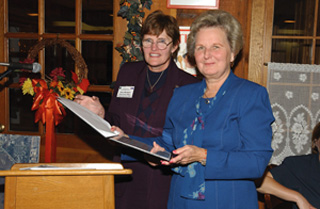 |
|
Andy Mravca by Pamela Zerbinos If you’re the founding director of a fledgling laboratory, and you’ve designed a spiral staircase that’s modeled on the double helix, and you know that Illinois law requires all ornamental staircases to have a radius of at least 75 feet, what do you do?
You call Andy Mravca. “Andy didn’t bend the rules,” said former Fermilab director John Peoples, “but he knew how to negotiate through them so that things were done, and done right.” Thanks in large part to Mravca, Robert Wilson got his staircase; it leads from the ground to the second floor of the Proton Laboratory. Mravca’s long relationship with Fermilab began in 1968, when he arrived as Chief of Engineering for the Atomic Energy Commission’s Batavia Area Office. The AEC, predecessor agency to today’s Department of Energy, sent Mravca to oversee the engineering aspects of the newly commissioned National Accelerator Laboratory. He worked closely with Wilson to establish the infrastructure and architecture that continue to shape the lab today. “Other than Robert Wilson,” said DOE Deputy Area Manager Jim Miller, “no person had more influence on the development of Fermilab than Andy Mravca.” Mravca, 69, passed away on Tuesday, Nov.5, after a long battle with pancreatic cancer. His many contributions to the lab were honored in October by a joint Fermilab/DOE proclamation naming the lab’s newest cooling pond “Andy’s Pond” in Mravca’s honor. The proclamation was presented to his wife, Joan, at the DOE Area Managers National Conference, held at Fermilab on Oct.29. “Andy was always very enthusiastic about science,” said Peoples.“So enthusiastic, in fact, that his DOE colleagues would often jokingly accuse him of ‘going native.’ At the time, Fermilab wasn’t always everyone’s highest priority — it was just this funny basic science. But to Andy, it was very important.” Mravca’s dedication and skill helped Wilson build the lab in five years, just as he had promised Congress, and with $6.5 million to spare. In 1973, with Fermilab’s first accelerator up and running, Mravca was reassigned to the Clinch River nuclear reactor project in Tennessee.
He stayed away for only a few years, returning to Illinois to head the Reactor Engineering Division in the Chicago Area Office. In July of 1979 he returned to Batavia to serve as DOE Fermi Area Manager, a position he held until his retirement in January of 1999. “Andy was always incredibly helpful,” Peoples said. “I first met him in 1972, when I was here as an employee of Cornell. The AEC had rejected a proposal for the remote handling of neutrino trains, and I needed to come up with a new proposal that was acceptable. I didn’t really have a sense of what Andy did or what his job was, but he always figured out ways to get things done. Whatever it was, Andy would find a way.” Mravca received his bachelor’s degree in mechanical engineering from the Illinois Institute of Technology, and went straight to work for the Atomic Energy Commission. The AEC awarded him a fellowship to study nuclear engineering at Pennsylvania State University as part of President Eisenhower’s Atoms for Peace Program. He was later awarded another fellowship to attend the Woodrow Wilson School of Public and International Affairs at Princeton. Mravca always applied his academic credits to the art of the possible at Fermilab. “When we were trying to build the Lederman Center,” Peoples said, “I think we must have had to redesign the building two or three times before it complied with DOE regulations. Andy was there the whole time, trying to make it work.” Mravca is survived by his wife, Joan; daughters, Andrea and Susan; son, Jim; brother, Robert; sister, Mary Ann Segvich, and five grandchildren. The legacy of his work is a laboratory that worked from its very beginnings. “He understood the rules, he understood how to build things, and he was very enthusiastic about science,” Peoples said.“He liked to get things done.”
|

